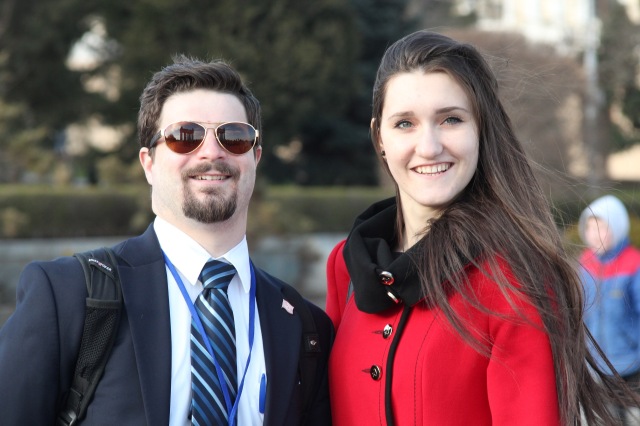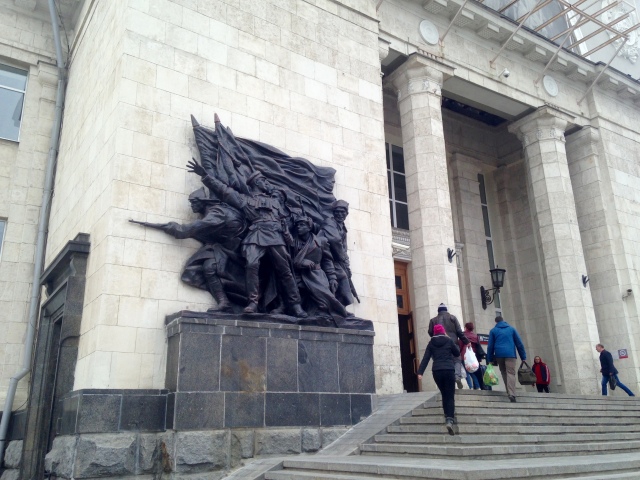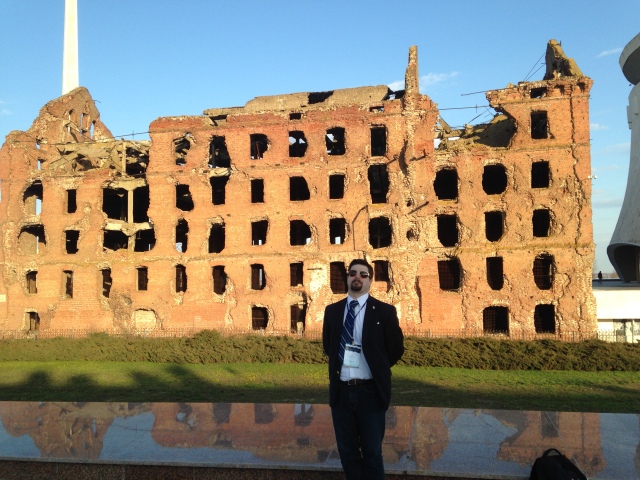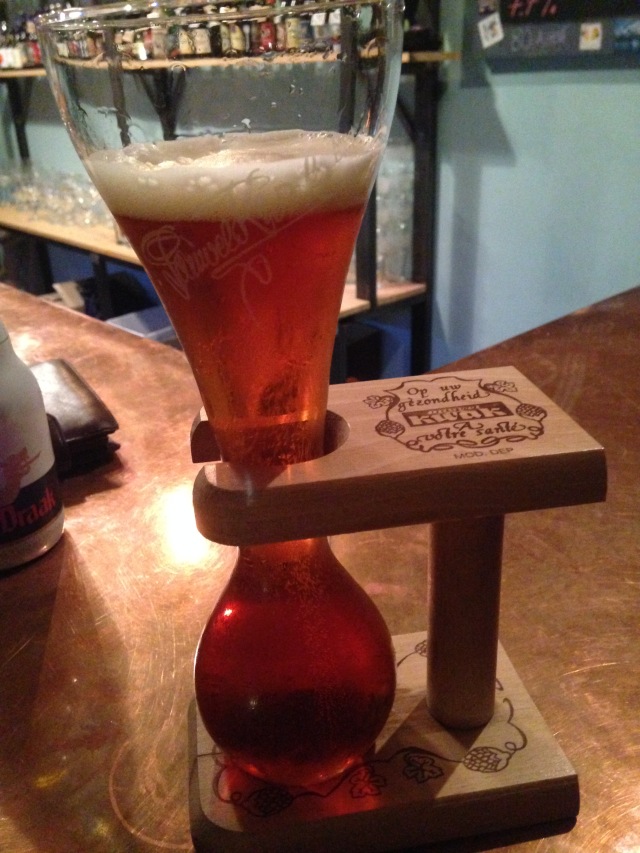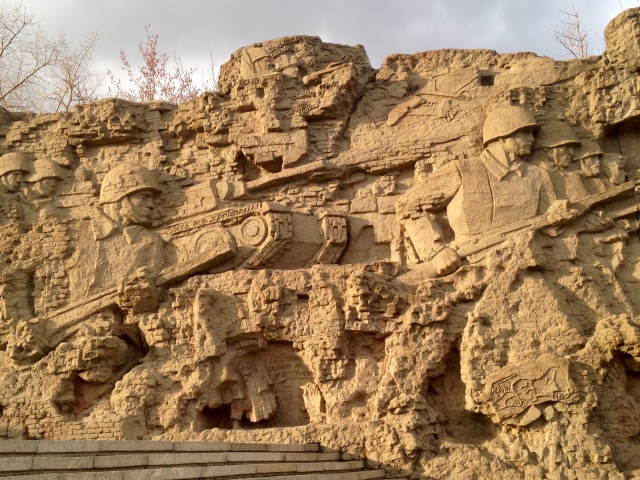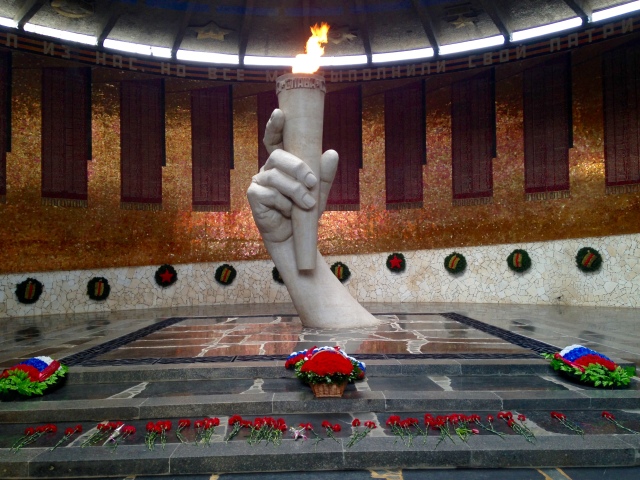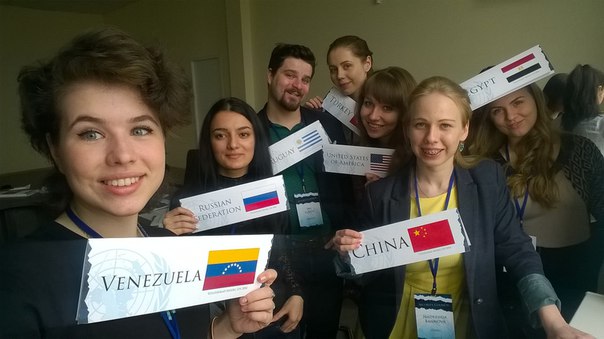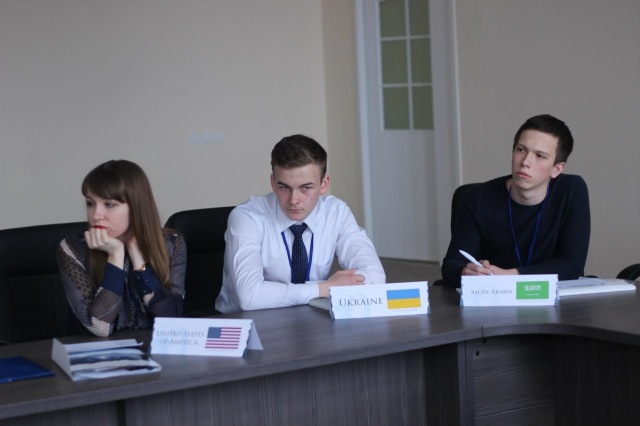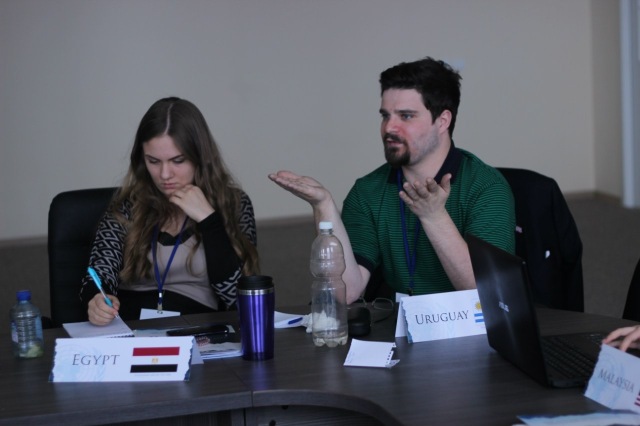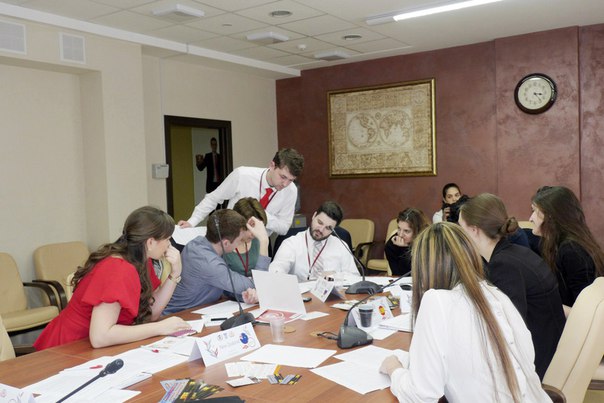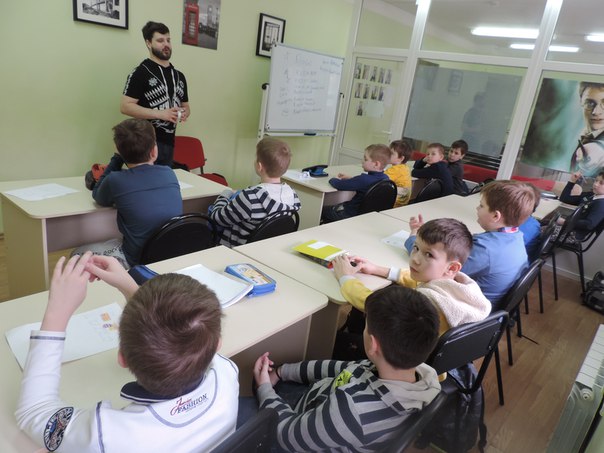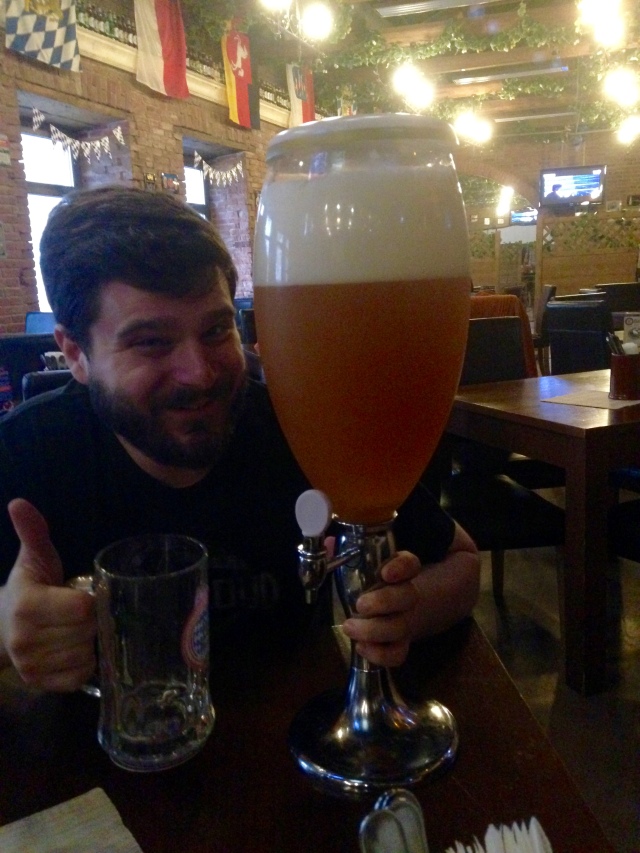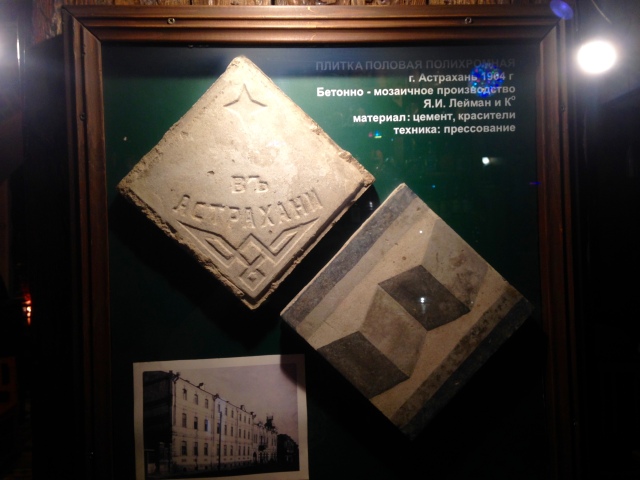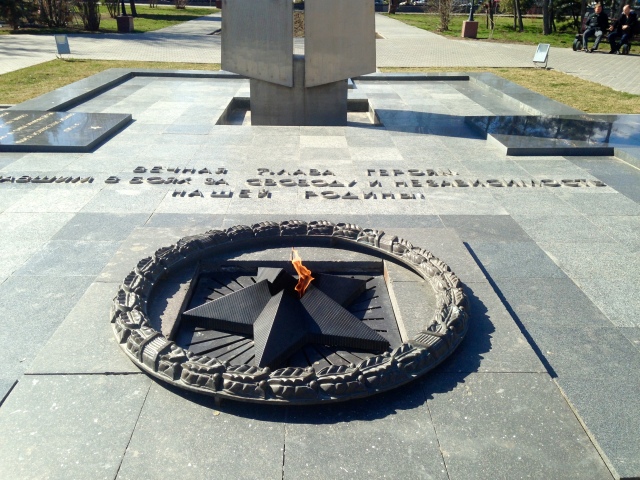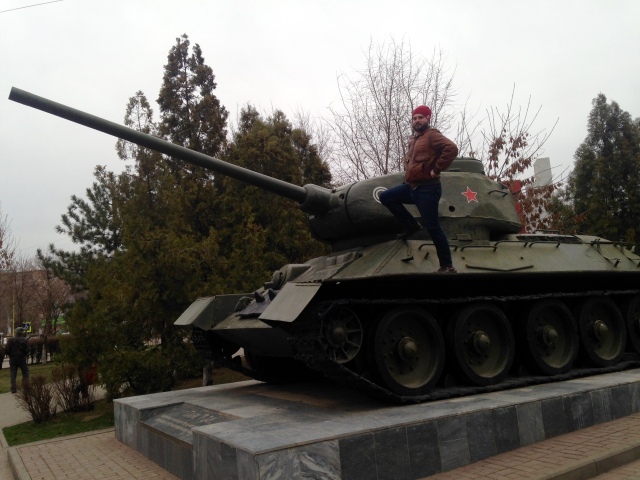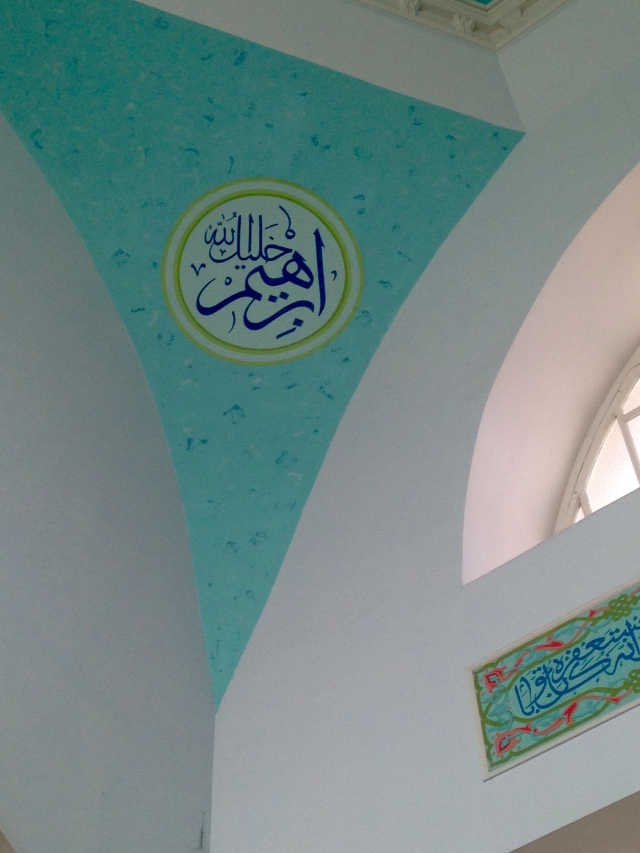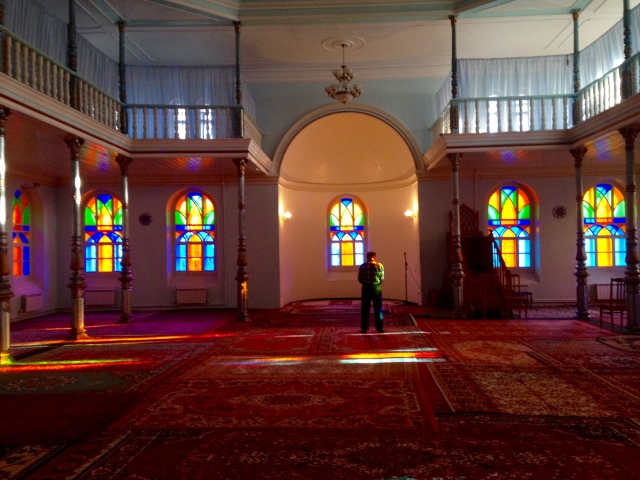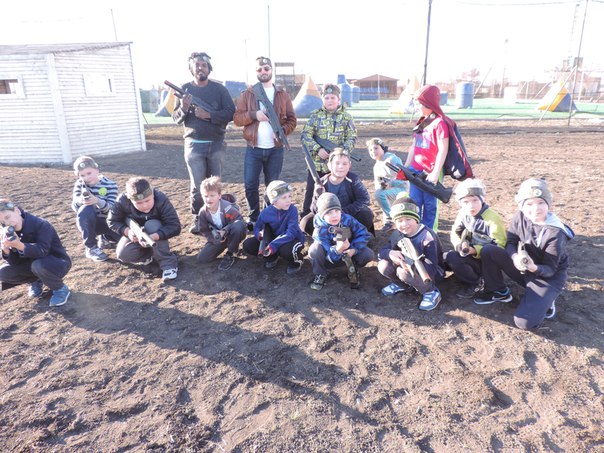Well, my friends, spring has finally sprung. The blossoms on the trees are peeping though, their pinks and reds look very nice amongst a background of green leaves and grass. Returning to Pyatigorsk and to the Caucasus in general is a blessing, the farther north I go, the less comfortable I feel. I returned from Volgograd just in time to see the Russian group, БИ-2 at their concert in Kislovodsk, a small city about a thirty minutes train ride southwest of Pyatigorsk. It is a nice city and it was my first time visiting it. I’ll have to arrange a visit when the weather is warmer and make it day trip. I went to the concert with Alina, Max and Saidat and I also saw some members of my faculty there at the concert too. БИ-2 (or BE-2 in English), was formed in the 80’s in Minsk, Belarus (then apart of the Soviet Union) and is one of the most successful Russian rock groups in the of the past twenty years. They were doing their, “Greatest Hits” tour and it was delightful to see them in person and to see Alina and the other fans dance and sing to their songs. One of the few times I’ve seen ethnic Russians openly expressing emotion in a huge public setting. The group is very popular in both generation X and Y camps, a fusion of late-Communist and post-Communist eras. We all had a very good time and thankfully the weather held up (it had rained all day).

The weather after the concert however, has been warm and the sun has been shining brightly. There have been a few days of clear, blue skies and it is such a relief to have such beautiful weather to match such beautiful country. On one of these crystal clear mornings, I walked down the hallway to wash my clothes and saw Elbrus and the Caucasus range through the window. It was like seeing ivory colored teeth, touching the horizon. The snow has caped the mountains nicely, making it a very impressive view. No matter how many times I look upon these mountains, I always get a feeling of awe and excitement. I really need to make the time to travel and see Elbrus one of these days before I leave. I need to see the mountain up close, to see what Lermontov and the Circassians saw. Anytime I pick up a “Hero of Our Time,” I look at the book cover, the drawing of Grigory Alexandrovich Pechorin (the ultimate “Byronic Hero”) and his companion Maxim Maximyich, standing on a cliff, with Elbrus in the background. A scene I’d love to replicate.

It is no wonder that the flags of Kabardino-Balkaria and Karachey-Cherkessia have Elbrus as the center piece of their Republic’s flags. The beauty and majesty of this place is something that I will miss dearly when I leave in June. I’m already preparing to go home, packing a few things here and there, but there is still plenty of time to relish revising old places and enjoy touring new ones. Of course there are classes in-between and it has been very interesting getting back into the swing of a daily schedule of classes, when one is gone for three weeks. Model UN, Astrakhan and Volgograd were nice breaks and it is good to see places in Russia which are outside of the Caucasus, but I feel much better being back. It is better to be surrounded by mountains, green, good food, and lezginka. It is very interesting being a cultural representative for both the United States and Circassia while traveling north of the Caucasus. It was very surprising to know that most Russians north of Stavropol Krai know little to nothing of the region or it’s many peoples.
Being called “American Cherkess” and “dzhigit” (although I still need to perform riding on horse at a gallup, picking up objects from the ground while doing acrobatic-like tasks, or in short, dzhigitovka) by both friends and faculty here at Pyatigorsk and elsewhere, is a treat and it makes one think you’re doing something right. It is it an honor to be trusted in such a way. I got many compliments from people at the Volgograd UN Model for my interest in Circassian culture and for my wanting to participate in cultural activities (especially after dancing lezginka at the dance there). Speaking of culture, the university hosts annually a Day of Nationalities at the end of April. This institution as set up to encourage understanding and knowledge about the various ethnic groups who makeup the community here at Pyatigorsk. During my first year here, it was a marvelous experience. The whole of the lobby at the university was packed full of tables, each one having a group of students representing their ethnic groups cuisine, culture and dance. Every ethnic group, from Cossack to Ukrainian, Chechen to Kabardian, as well as some of the foreign nations including Chinese, German, Polish and Georgian had a table, filled with food, flags on the corners and individuals wearing their national regalia. I was in heaven. I went to every table, eating, talking with and observing each nation. It took around two hours to get through them all and I was so fat afterward from eating all the food. I then needed a rest. Thankfully, after the buffet of nations, there is a Nationalities Concert that allows each nation to perform their traditional dance or dances. It is quite the spectacle.
This time around, I was serving a table. Andrew, his wife, Kristi and I had the opportunity to represent America, specifically the South, as we are all originally Southerns. We spent most of Thursday evening cooking food for the event. We had a lot to cook, but thankfully we also had many helpers (13 people in one kitchen, yikes). A big thanks to Alizee and Florane for helping us. It is wonderful to have Belgians, Russians, Turks and Nigerians help cook an “American feast.” In my opinion, it personifies Americanism and makes me recall my nations motto, E pluribus unum, “Out of Many, One.” The menu as I said above was very Southern. We made separated into groups to make the cooking more manageable. I was responsible for preparing the baked beans. Nothing too fancy, just seven cans of beans, tomato sauce, two onions, garlic, spicy mustard, paprika, a cup of sugar, and a squeeze of hot sauce to literally “spice things up.” The others made: pulled BBQ chicken, potato salad, coleslaw (this is painful trying to explain in Russian), and sweet tea. It all reminds me of humid summer evenings, with the June bugs flying into everything and the cold glasses of sweet tea and lemonade “sweating” it out in the heat. Kristi is also baking a chocolate cake and she made butter cream frosting. Cakes in the rest of the world are a joke compared to a good, old American style cake. I’m apologize to my foreign readers, but for me, American cakes are second to none. The cake itself is so moist and dense, and the frosting is the best, none of that whipped cream or flan shenanigans. I’m not saying that European cakes aren’t tasty or good, I’m just saying I prefer American cakes over them. I had a funny comment to me, while cooking the beans. A Russian girl was watching me and cook and said in English, “Do you eat that?” I responded by saying, “Why would I cook this for Day of Nationalities if you couldn’t eat it?” I guess beans are not a thing in Russia.
Nationalities Day was a lot of fun. It was just and great to serve food and represent my own nation as it is sampling all the food of others. We showed out dress in flannel shirts (in red, white and blue) and jeans. I also had my United States t-shirt that says, “Established in 1776.” We had a lot of turn out for our table. We took turns serving and holding the American flag (as there was no wall or pole to hang it on). I showed a few Russians the tradition of folding the flag and how to hold it when folded. They thought it was cool that America had this tradition of respect for the flag and a unique way to fold it. I know it’s something I love about my own culture. Across from us was the Russian table, so it was nice have so friendly competition. Poland and Germany flanked us, so it was a “NATO zone.” I hope the Russians missed out on the irony. I held the flag at the beginning, taking part in two interviews for the universities student media. I answered questions concerning what we cooked and that it was all traditional Southern style cooking. One the of students commented, that she was, “I’m surprised not to see McDonalds.” I replied by saying that I was, “sorry to disappoint, but there’s one across the street.” Her comment left a bitter taste in my mouth, but I was glad that we we’re living up to stereotypes. It was great to see the Russian students branch out and try new things, but with some encouragement. They loved the BBQ chicken, but at first didn’t know what to make of it, the same thing with the beans. The potato salad was popular, as the Russians have something similar, so the less adventurous individuals ate that. The chocolate cake was by far the most popular and disappeared quickly. Kristi made two of them and still within 45 minutes, both were gone. Our faculty was very happy that we did this, as the our faculty was also in charge of representing Poland and Russia. Marta (the Polish girl, who teaches Polish in our faculty) had a wonderful table and had her students helped serve. I liked the Polish dish with apples, salmon and sour cream, an interesting mix of favors. On my “break” I ventured to other tables and got food from the Georgians, Greeks, Azeris, Kabardians, Chechens, and Polish. I also had a little of the Chinese food, but they wanted people to pay, so that was a disappointment. We gave out food for free, but expected donations. By doing this, the kind nature of the Russians and Caucasians worked in our favor and we received more funds (to pay for the expense for the food). I had a lot of fun, as Nationalities Day is one of my favorites festivals at the university. To my knowledge, this is the first time America has had a table at Nationalities Day, so it was an honor and a new experience to serve food at the event.
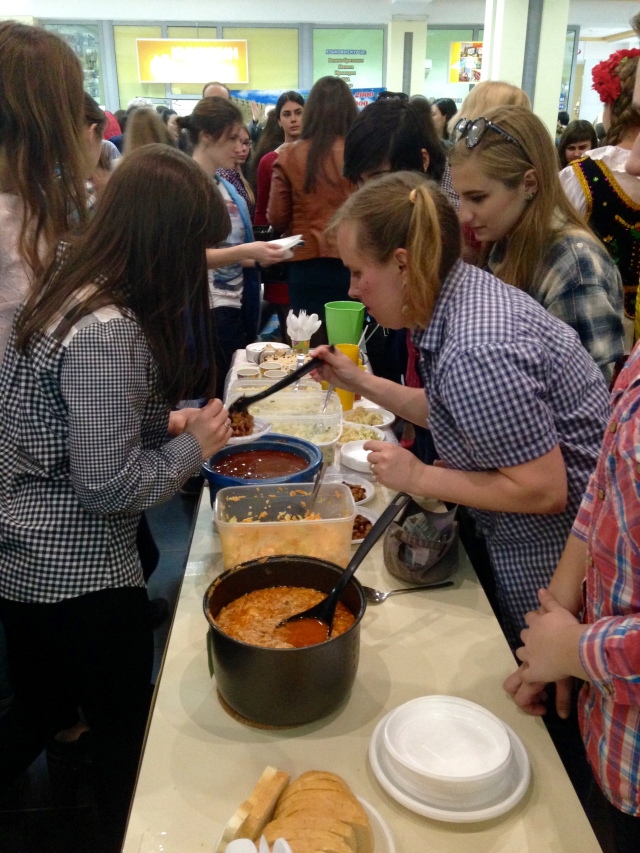
On Sunday, Vika and Alina invited me to join them at a church service. As some of you may know, the Orthodox faiths (Russian, Greek, Serbian, etc.) follow the older calendar so the religious holidays are few days or even weeks apart in some cases. Last Sunday as Palm Sunday or in Russian, “Willow Sunday,” as they use the willow branches as opposed to palm furans as palm trees are a rarity in Russia (though there are palm trees on the coasts of Krasnodar Krai, Yalta, Abkhazia, and Georgia). Before we entered the church in downtown Pyatigorsk, the girls bought a few willow branches and candles. We then crossed ourselves and entered, people buzzing about the insides of the church. It seemed very disorganized at the start, as there are no pews. One stands for the whole three hour service. In a typical Russian Orthodox Church, there is an open center, with pillars supporting the structure and the domes or cupolas. On the walls of the church are icons to various Saints, including George, Andrew etc. in front of this hand painted icons are places to put candles. A tradition is to place a candle for the patron Saint and make a prayer. As an example, Saint George (the patron Saint of England, Russia and Georgia) is the patron Saint of soldiers. If one wants to pray for a soldier, one simply puts a candle at Saint George’s stand and pray. I give a candle to Mother Mary and prayed. Very important Saints such as Mary, Matthew, Mark, Luke and John, are on the Iconostasis or a “the door way between Heaven and Earth,” “the wall separating the divine from the secular.” In the Russian Orthodox Church, there is a wall separating the parish from the parishioners, symboling the divine between God and humanity. It is a sobering symbol, and reflect Russian cultural norms (the collective and authoritative native of Russian society). The priest is the main authority and from what I observed, there is little participation by the parish, only crossing one’s self (similar to the Catholic and Episcopal bowing) and bowing when the priest sings a phrase, praising God. All of the litany is sung in Old Church Slavonic, but I my surprise, I understood a lot. The Nicene Creed is the same as is the blessing of the bread and wine during Communion. It’s nice to see familiar symbols seven thousand miles away. The willow branches were used to sprinkle holy water on the people by the priest (they also wear a kind of papakha, that has a purple cape, I love the Caucasus), it was cool, and it is an interesting difference, as we burn the palm furans on Ash Wednesday.
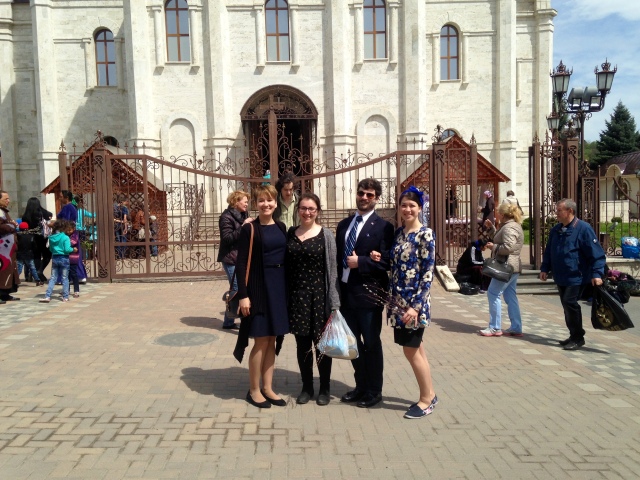
Continuing this theme of culture, I also had the opportunity to experience and participate in Circassian Flag Day in Nalchik. Annually, the Republic of Kabardino-Balkaria, hosts a rally to celebrate the national flag of the Circassian Nation on the 25th of April. Circassian Diaspora from all over the world also partake in the celebrations by doing their home rallies, posting photos online of the flag and doing cultural activities such as dancing and cooking traditional foods. The large Circassian communities in Jordan, Israel, and Turkey have made a huge Facebook community for the event, asking people to change their profile pictures or cover photos to the Circassian flag titled, “Make It Green” in English and Arabic. So, I changed my cover photo for the day, and headed with Maddy to Nalchik. Alas, Anna could not attend the event, as she had an exam that afternoon. I know however, she was with us in spirit. Trying to arrange meeting with my friends in Nalchik was a nightmare. Elberd was working as crowd control that morning and from most of the afternoon, but he agreed to meet us at 5 o’clock in the evening at Abkhazia Square. Meeting with Jan and his friends as a little more problematic, as they had classes and wouldn’t be free until in the mid-afternoon. With is disorganization, we “punted” and headed to “Circassian House,” the shop that sells Circassian cultural items and apparel. It was good to see the Nastya, one of the employees that works there. I said hello, with I walked in and she greeted me with a smile and responded in informal speech, which I was taken aback by, but I guess when you visit the shop every time you go to Nalchik, and are I good patron, you can get friendly. I needed to pick up a new kindjhal (a short sword or dagger that is worn on the belt, it mean in Adyghe, “short knife.”), as one can’t wear a cherkesska without the blade. I bought a smaller, ceremonial one when I first visited Dombai, but I left it back in Nebraska, as I feared customs leaving the U.S. or entering Russia would nab it. So, now I have a full, “battle” version of the blade.

Nastya was so excited (maybe more so than I), as she help me put on the cherkesska on, adjusting the belt here and the kindjhal there, making sure I looked my best in the “clothes the fit you.” The scabbard of the blade is the same shade of red as the scabbard of my shashka, making it a perfect match to the red trim of my cherkesska. I looked the part, boots, papakha and all. Nastya then took a few photos of me in forward of the shop, as did Maddy and we then presided to walk the streets of Nalchik. While in “Circassian House,” Maddy got a magnet for our friend, Molly and we also got a PPC pipeline, about a meter and a half in length, which we used as a pole of the flag. I got in free of change, which was very nice and I handed Maddy a white version of a Adige flag t-shirt that I had bought with me. She looked the part as well. Walking through Nalchik was an interesting experience. People who walked by were taking photos and videos of us and asking to take photos with me. I felt a prop, and now I understand how Diogo feels when walking on the streets of any Russian city. People also asked us, “What holiday is it?” or “why are you all dressed up.” We were shocked. The fact that people didn’t know what was going on, after this festival happens every year, (later on, Elberd informed me that the Circassian Flag Day festival as not an official holiday in Kabardino-Balkaria, as opposed to the Anniversary of the Deportations and has only been going on since 2010) and with all the Circassian flags flying around, I would have thought someone would have taken a hint. We wee told by some fellow “flaggers,” that some if the people who asked “What holiday is it?” may have been Balkarians (the Turkic speaking ethnic group that is the minority in Kabardino-Balkaria), who were making fun of us and “pulling our leg.” At any rate, we didn’t let in bother us and we continued walking to “White House Square” and around the “400th Anniversary of the Union Square,” displaying the flag.
The Circassian flag has a rich history and meaning, and as I recall, I’ve mentioned some of the specifics in a pervious blog. The flag is the official flag of the Republic of Adygea (adopted in 1992), but is also used and shared by the all Circassians living in Kabardino-Balkaria and Karachey-Cherkessia (as well as by diaspora over seas). The flag isn’t new though, as it was first drafted (allegedly) by Scottish scholar and British statesmen, David Urquhart. The original flag was designed in 1834 and only had seven stars, being flown by the Circassian Nation during the war with the Russian Empire (1763-1864). The golden arrows on this flag are said to represent the political and military union of Georgia, Armenia and Azerbaijan, the stars then symbolizing the alliance of the Circassian tribes (this is according to French scholar Pierre Charles Lux-Wurm, though I question, this as Azerbaijan during the 1830’s, was not an independent entity, being ruled by the Russians after the Russo-Persian War of 1826-1828 and formalized during the Treaty of Turkmenchay). The golden color of the twelve stars and third arrows, represents the rich soil and harvests that the Caucasus provide for the Adyghe people. The current flag’s symbolism was developed by the North Caucasian League during the 1940’s and has twelve golden stars, nine of which stand of the aristocratic or feudal roots of the tribes, whereas the bottom three stars stand for the democratic elements within these specific tribes. The three crossed arrow represent peace and strength and the background is green, representing both Islam and the natural beauty of the Caucasus. It should be known that the color of the flag is in fact aquamarine green, a dark bluish green, as opposed to a light or medium green. According to the laws adopted on the flag on March, 31st of 1992, this is the official color. Activists such as Nikolay Khimenkov have spoken out against the making and selling of flags with “incorrect” color schemes and even went so far as to write to the various companies that make said flags to correct their mistakes. My friend Elberd, made a point of these when we were buying my flag from “Circassian House” in Nalchik, back in November. Though I’ve seen many flags of the light or medium green variety fly in both Nalchik and Maikop. Thankfully, my flag is up is snuff.
An interesting note on the flag, historically the various Circassian tribes within the confederation were also made up of other Caucasian ethnicities including Nogay, Ossetians, Balkars, Karachey, Ingush and Chechens. In the 19th century, three of the twelve tribes replaced their feudal systems (many of the tribes ruled themselves in federal, tribal based confederacies that had set territories and were autonomous from one another, functioning together in times of conflict and regional administration) with that of direct democracies (some scholars such as Tony Wood, argue that these tribes borrowed this system from the neighboring Chechens), but this was short lived after the Russians conquered Circassia in 1864, ended their independence. Another fun fact is there is a second flag of Cherkess origin (Circassians living in Karachey-Cherkessia) and that of diaspora. This flag is identical to the Adyghe flag except for a yellow background and orangish-red stars and arrows. In regard to way it is different, I honestly have no idea. Elberd, made the comment that is was “very strange, I think they don’t know what they’re doing.”
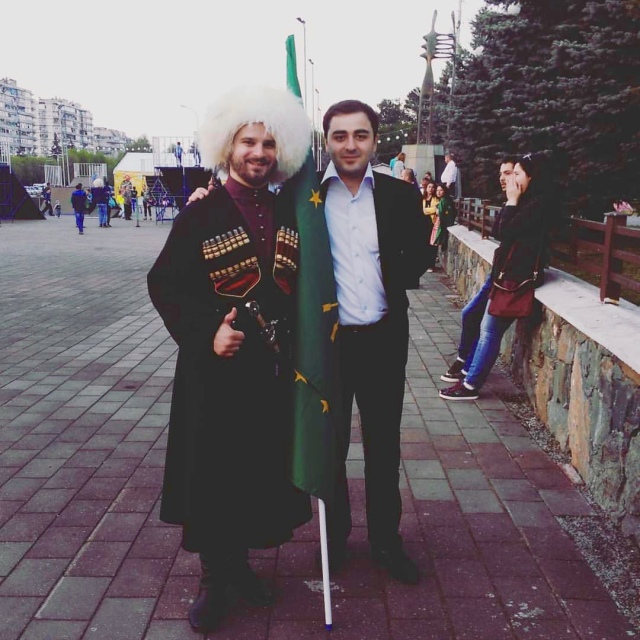
At around 12 o’clock in the afternoon, the motor rally started driving around on the main streets on Nalchik. We figured if we followed the cars with the Circassian flags displayed either on, or within them, we’ed find the start of the rally. Just by fate, good timing and luck, we ran into them, an impressive looking Kabardian man, dressing in a red cherkesska, rode on an equally impressive looking Kabard horse. With the reins in one hand a big Circassian flag in the other, he shouted, “Adige Wei Wei (loosely translated, meaning “ to Circassian success,” or “Long live, Circassia”). He galloped down the street, to police cars followed suit, blocking the road from traffic and made 40 to 50 cars followed behind. The cars had three or four people in them, holding Circassian flags outside of the passenger windows, some of the men even sat on the space where the widow would have been, their torso and upper body, sticking out. I quickly crossed the street with in was safe and waved my flag left and right, shouting “Adige Wei Wei,” the men in the cars, honked the horns of their cars, gave thumbs up signs, smiled and yelled in either Russian or Kabardian. Some even took photos of me when their cars stopped at the crosswalk. I was beaming with excitement, as I was participating in the Circassian Flag Day rally. Maddy took a ton of photos of the cars passing by and it was cool to see so many people turn out just for the motor rally. Maddy and I then headed to the park in Nalchik, to see if anything was going now there and to also take advantage of the gorgeous weather. The sun was shinning bright and warm, the wind, a gentle breeze that made the flag I was carrying came to life.
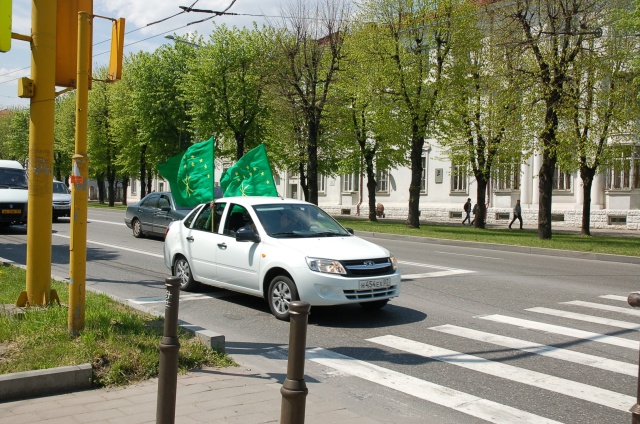
After a nice about the park, we got hungry and head to “Amal`e” restaurant, a nice place the serves traditional Kabardian and Caucasian dishes. Whenever I’m in Nalchik, I order traditional Circassian cuisine, so I had an order of psihekive melt delhu, (Circassian monti or meat dumplings with sour cream) and ligor with ships and p`asta (ligor, is sun dried strips of beef, like jerky, ships is seasoned, white cream sauce, and p`asta is made of husked millet, which is shaped into thick, regular blocks). You traditionally, eat this dish by putting the ligor and the ships on top of the p`asta, softening it and letting the sauce absorb into it. Maddy had khichiney with cheese and a Russian salad of some variety. To my surprise, Maddy had never had it khichiney before, so it was nice to a witness to a “first.” Of course we shared some lakum as well, one can’t go have a meal anywhere in with Republic without having a basket filled to the top with lakum. It was a nice meal, and I now have practice eating food while in full cherkesska. It was interesting, with all the belts and blades on my person, but it is nice that the cherkesska is comfortable, breathes well and isn’t very heavy. We then left the restaurant with full tummies and continued on our marry way to Abkhazia Square. There however, was confusion as who, where and when we were meeting. After talking to several Nalchik natives and playing telephone tag with Elberd, Anna, Jan and friends, we finally managed to get things straight. I was disappointed that in the chaos, we lose time to see Jan and his friends perform at the local university that they study at. It would have been great to see and listen to them play traditional Kabardian instruments, such as the: shik`epshine (a thin, stringed instrument), qamalapsh, (a Circassian, made from dried water reeds), apa phsina (a three stringed lute), pxachach (two sets of wooden blocks that are held by hand and struck together to indicate the beat of the song), drums (dhol, in Kabardian), and the pshina (an accordion). Apparently, Jan’s friends can play this instruments and they both played at the university and at the festival on Abkhazia Square that evening.

When Maddy and I arrived on Abkhazia Square, we were some of the first people there. As we wanted for the festivities to begin at 6 o’clock, I was again asked for photos by at least twenty people, even the police wanted photos with me. It was odd at times because they’ed come up and ask first in Kabardian (a language I’d love to learn, but is very different, with a complex grammar structure and a alphabet of 53 characters, of which exist only three vowels) and then in Russian when I told them what I didn’t speak Kabardian. I probably would have made over a thousand rubles that day, if I changed just a hundred for each photo, but it is a holiday, no need to be greedy. After a little while, Jan and his buddies showed up and we chatted, took photos with each other and the Circassian flag. As the sun started to set, Elberd when walked over to us and we embraced. I was so happy to see him, my Kabardian brother. I told me he was held up at the motor rally, making sure all the cars and horses, had a place to be without interfering with the crowd of over 700 to 800 that slowly gathered in the square. The procession was led by three, brilliantly dressed men in green, red and grey, cherkesska. The horses were very nervous from all the people, whining and stamping their hoofs on the pavement, making a “chip chop” sound. The men on horseback, quickly got the horses out of the square, walking them near where I was standing with Elberd, Jan, Maddy and the others. I was so close to them that I could see their horses wild eyes and the stubble on the riders faces. I moved out of the way, to keep my distance from them. The procession then gathered in a large mass, the master of ceremonies, the musicians, the elders and famous individuals such as the Director of the International Circassian Association (ICA), sat on an elevated set of platforms.
Circassian Flag Day is also celebrated in the Republic of Adygea (and to a lesser extent in Cherkessk, Karachey-Cherkessia), in the capital of Maikop, a city of ancient origins, which is said by some scholars to be the birthplace of Maikop culture (the root of all Greater Circassian cultures, including that of the Kabardians). The events in Maikop are similar to those that are held in Nalchik, with an automobile rally that is sanctioned by the city administration. Dance contests are also held. Last year the famous group “Adyghe Djegu” performed at the celebrations. Some, 1,700 residents of Maikop take part in the festivities each year and the usually Aslan Djarimove, (Adygea’s first president) attends the rallies (according to the news paper Caucasian Knot). He played an important role in the adoption of the flag as the Adygea’s national flag. Other pan-national figures may so attend the event, including Arthur Bagadirov, the chairman of the “Youth Wing” within the “Adyge Khase-Circassian Parliament,” as well as Adam Bogus (the chariman of the adult movement). At our festival in Nalchik, we had a few famous singers perform songs in both Russians and Kabardian. I was hoping to see the Kabardian artist, Azamat Bishtov there, singing “Circassian Flag,” but alas he wasn’t to my knowledge there. I stood in the back at the beginning, to talk with Elberd, the others heading to the front for the stage. We discussed a lot of the ceremonies agenda, and switched to politics and our families. We got a lot of catching up done. I then headed to the large circle that was being formed around the master of ceremonies, a tall Kabardian man, wearing red cherkessak and a tall, black papakha (he certainly looked the part). He had in his hand, a wooden stick, about a foot long, which was decorated with red tassels and he would point to a man to indicate that it was his turn to dance Kafa (the opening traditional dance between a pair of men and women, that we started the festival with). The men and the women were separated from one another, a female master of ceremonies, indicating to the women, when they could dance. She wore a beautiful, white traditional dress. Little children of about four to five years of age danced first, they looked so cute. I also had the opportunity to dance and it was a good experience both for practice and to partake in such a traditional and lovely celebration of culture.
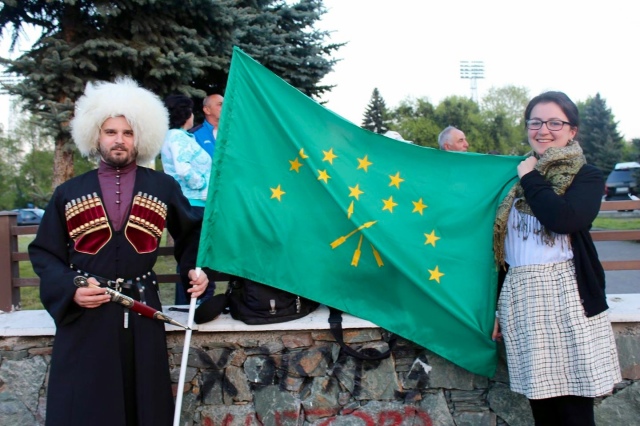
Both Nalchik and Maikop, put on a very remarkable show during the celebrations and I wish I had the opportunity to see the festivities in Maikop in person, but alas, it’s a seven hour bus ride from Pyatigorsk. Nalchik is only an hour away, so it is easier to travel back and forth. Having been to Maikop in May of two years ago however, for the Victory Day holiday, I’ve seen the city and it would be nice to see a Circassian celebrations here. Perhaps I’ll go to Maikop for the 151st anniversary of the deportation (or genocide as some scholars and Circassian nationalism write), but we’ll see. I think going to Nalchik will be cheaper and Anna, Jan and Elberd will be there. Well, that’s all folks, I wish you all very well. Thanks for reading and keep an eye out for I next blog, about my trip to Georgia. From Russia with regards, Adige Wei Wei.




